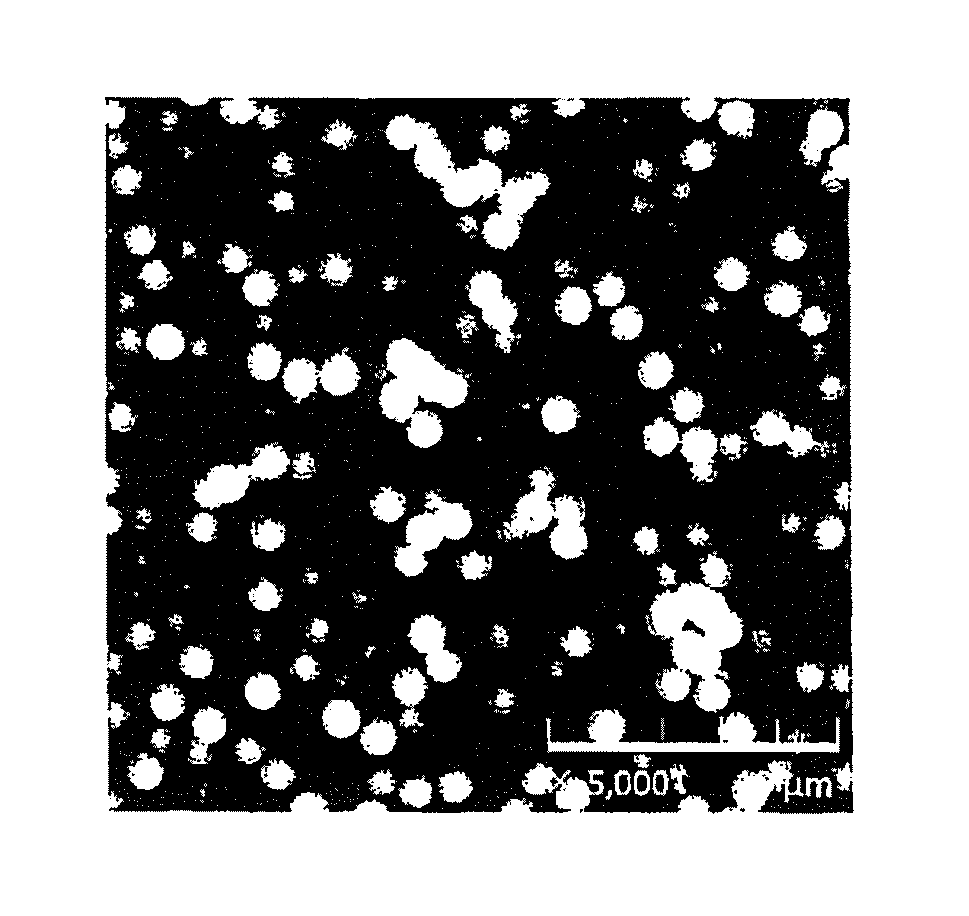Spherical silicon oxycarbide particle material and manufacturing method thereof
a technology of oxycarbide and spherical silicon, which is applied in the direction of carbides, manufacturing tools, other chemical processes, etc., can solve the problems of high production cost, difficult and cheap, and the desired performance improvement is yet to be obtained, and achieves good uniformity and dispersion, simple, inexpensive and efficient
- Summary
- Abstract
- Description
- Claims
- Application Information
AI Technical Summary
Benefits of technology
Problems solved by technology
Method used
Image
Examples
example 1
Preparation of Silicon Oxycarbide Precursor
(Synthesis)
[0091]222.9 g of a pH 5.3 acetic acid aqueous solution adjusted to 1.3 ppm by weight was added to a 500 mL four-necked flask under continuous stirring, wherein a mixture of 27.24 g of methyl trimethoxysilane (0.200 mol) and 9.91 g of phenyl trimethoxysilane (0.050 mol) was drop-wise added thereto. After drop-wise addition and stirring at room temperature for 2 hours, 7.90 g of a 0.37% by weight ammonia water was added drop-wise to the solution with stirring, wherein the pH of the solution becomes 9.5. After drop-wise addition and further stirring at room temperature, stirring was stopped, and the solution was left to stand overnight.
[0092]The obtained cloudy liquid of polysilsesquioxane was filtered through a 100 mesh wire netting and filtered through a membrane filter with an opening of 1 micrometer under suction to obtain 19.34 g of spherical polysilsesquioxane.
[0093](Preparation of Silicon Oxycarbide (SiOC) Sintered Product)
[0...
examples 2-6
[0097]Besides adjusting the amount of the 1.3 ppm acetic acid aqueous solution with pH 5.3 and the amount of 0.37% by weight ammonia water used in example 1, and adjusting the pH and reacting conditions according to Table 1, the spherical polysilsesquioxane and polysilsesquioxane sintered particles are obtained by conducting the same procedures described in Example 1.
[0098]The particle size distribution measurement, circularity coefficient (sphericity) and elemental analysis measurement results for the obtained spherical polysilsesquioxane sintered particles are presented in Table 1.
example 7
[0099]Besides sintering the spherical polysilsesquioxane particles obtained by the reaction conditions used in Example 6 in Table 1 at 1000° C., the spherical polysilsesquioxane sintered particles are obtained by conducting the same procedures in Example 6.
PUM
| Property | Measurement | Unit |
|---|---|---|
| particle size | aaaaa | aaaaa |
| temperature | aaaaa | aaaaa |
| particle size | aaaaa | aaaaa |
Abstract
Description
Claims
Application Information
 Login to View More
Login to View More - R&D
- Intellectual Property
- Life Sciences
- Materials
- Tech Scout
- Unparalleled Data Quality
- Higher Quality Content
- 60% Fewer Hallucinations
Browse by: Latest US Patents, China's latest patents, Technical Efficacy Thesaurus, Application Domain, Technology Topic, Popular Technical Reports.
© 2025 PatSnap. All rights reserved.Legal|Privacy policy|Modern Slavery Act Transparency Statement|Sitemap|About US| Contact US: help@patsnap.com



